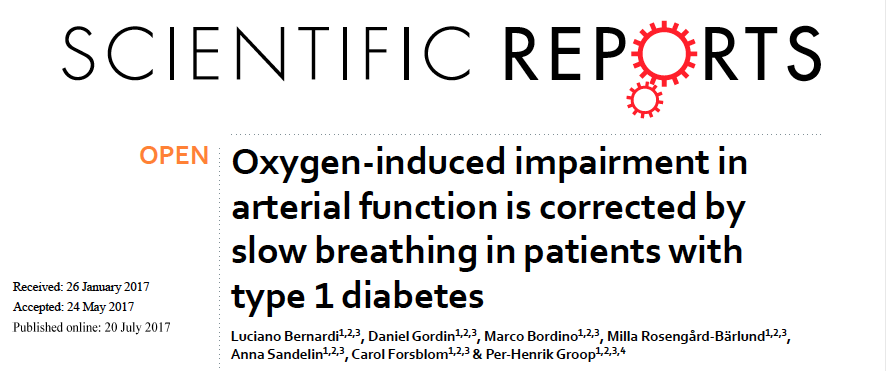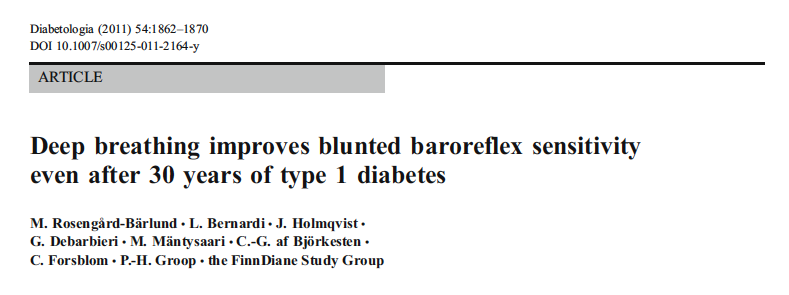Slow, Diaphragmatic Breathing
Articles are listed in the order that I read & reviewed them. For example, if you want to see the latest article I have read related to this topic, scroll to the very bottom.
Diaphragmatic breathing lowers HbA1c by up to 2%
Diaphragmatic breathing improves antioxidant status & HbA1c in type 2 diabetics
Slow breathing improves autonomic function in type 1 diabetics
Diaphragmatic breathing reduces oxidative stress in athletes after exhaustive exercise
Autonomic function can be restored by slow breathing even after a long-duration of diabetes
Relaxation improves HbA1c to a greater extent than moderate exercise
Slow breathing decreases blood pressure, heart rate, and sympathetic nerve activity in mildly hypertensive patients
Relaxation breathing significantly lowers blood sugar after an oral glucose tolerance test
Slow breathing improves blood sugar by reducing body’s endogenous production of glucose
Diaphragmatic breathing increases insulin, lowers blood sugar, and reduces oxidative stress
Controlled breathing lowers sympathetic activity, even when performed at a relatively fast pace
A sitting breathing exercise lowers the blood sugar of type 2 diabetics following a meal
Slow breathing improves autonomic function to same extent as oxygen administration
Even short bouts of high blood sugar significantly increase oxidative stress
Slow breathing decreases blood pressure and increases heart rate variability in hypertensive diabetics
Slow breathing improves blood pressure in hypertensive type II diabetics
Slow breathing for less than 5 min/day reduces blood pressure
Reduce blood pressure easily, without negative side effects, using slow breathing
Breathing slowly reduces blood pressure, natural breathing rate, and sympathetic activity
Two minutes of slow breathing restores autonomic and respiratory balance
Ten minutes of slow breathing significantly reduces blood pressure
Breathe slowly (and pause) to improve heart rate variability
Balance your breathing: equal inhales and exhales for better heart rate variability
Daily practice of slow breathing leads to higher resting heart rate variability
Inhalation-to-exhalation ratio plays key role in relaxation and heart rate variability
Slow breathing is the best “workout” for your autonomic nervous system
Controlled breathing reduces the frequency and severity of panic attacks by increasing carbon dioxide levels
Slow, controlled breathing improves anxiety independent of CO2
Biofeedback improves panic disorder by reducing breathing rate and increasing CO2
More evidence that CO2 biofeedback reduces panic disorder through reducing breathing rate and volume
Sighs during sleep: Good or bad?
Excessive sighing might explain low CO2 in panic disorder
Breathing and relaxation reduces heart rate and breathing rate in heart attack patients
Slow breathing reduces spontaneous breathing rate, increases resting oxygen saturation, and improves exercise performance in chronic heart failure patients
The saliva produced during yogic breathing beneficial to health
“Spit out” inflammation with Yogic breathing
A pivotal paper: The fundamental roles of the breathing and cardiovascular systems in diabetes
Treat & reverse the root cause of diabetic complications (tissue hypoxia) with slow breathing
Slow breathing restores autonomic function in type 2 diabetics with severe complications
Oxygen administration increases arterial stiffness in type-1 diabetics
Slow breathing reduces sympathetic activity and improves autonomic function in COPD
Diaphragmatic breathing improves subjective and physiological indicators of anxiety
How slow breathing improves physiological and psychological well-being (hint: it might be in your nose)
Yoga breathing program significantly reduces PTSD in Australian Vietnam veterans
Low Heart Rate Variability is linked to Enhanced Stress Response in PTSD
Nasal Airflow Activates Broad Regions of the Olfactory Bulb
Slow Breathing at Six Breaths per Minute Improves Baroreflex Sensitivity and Reduces Blood Pressure
Meta-Analysis: Slow Breathing Reduces Systolic Blood Pressure by 5.62 mmHg
2020 Meta-Analysis: Slow Breathing Improves A Variety of Behavioral and Physiological Outcomes
Make it stand out


















































